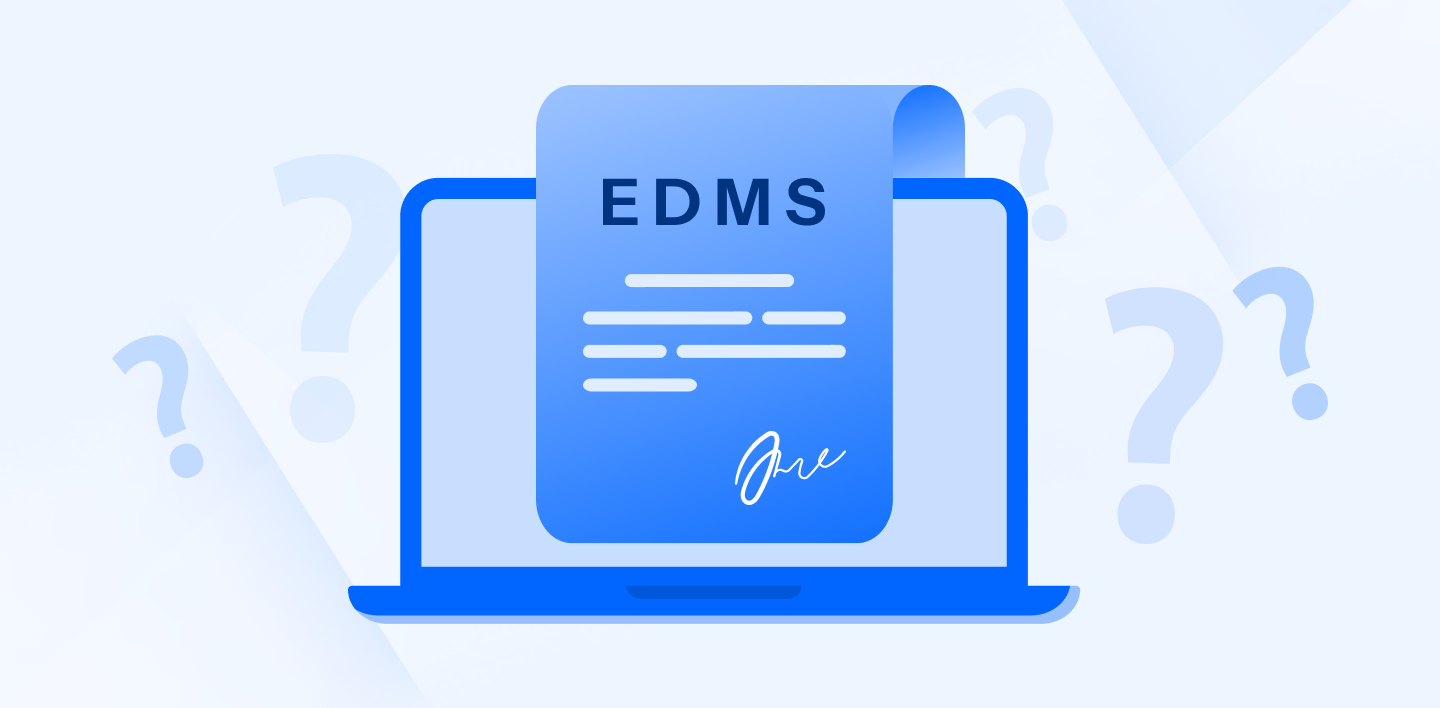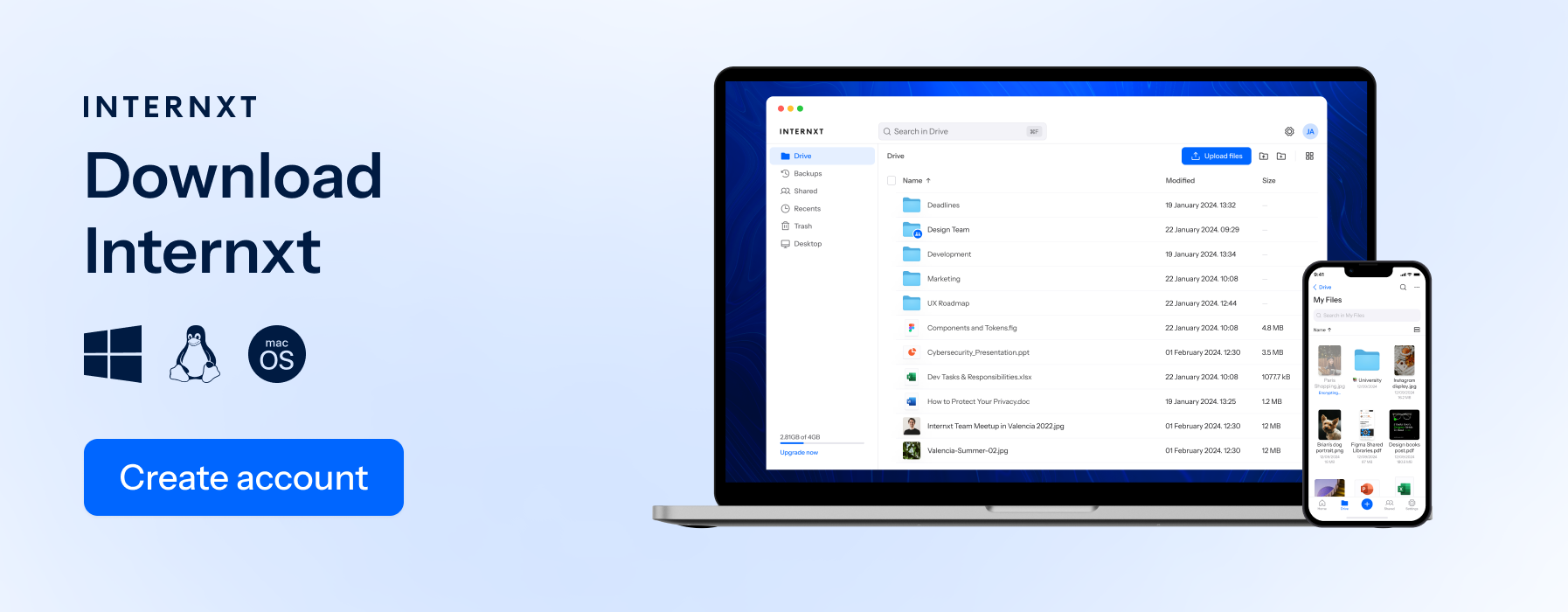What Is an Electronic Document Management System (EDMS)?

Managing documents is a crucial aspect of running a business efficiently. Most companies are transitioning from paper to digital formats to save space, money, and enhance security and privacy.
To meet these needs, businesses need to have a reliable Electronic Document Management System (EDMS). An EDMS helps manage document storage, retrieval, and sharing and ensures regulatory compliance.
The global Document Management Systems market was valued at $1050.89 million in 2023 and is expected to reach $1290.82 by 2030, demonstrating a compound annual growth rate of 2.98% during the forecast period.
This article will explore features of EDMS that can help your company increase efficiency and data security, as well as keep your documents private to avoid unauthorized access or accidental leaks.
Table of contents
- Document organization and accessibility
- Security
- Document processing
- Disaster recovery and backup
- Regulatory compliance
- Collaboration and access
- Environmental
- Scalability
- Audit readiness
What is an EDMS?
An Electronic Document Management System, or EDMS, is a digital platform to manage, store, share, and organize electronic documents.
There are many major advantages for businesses if they use this system, one of which is that an EDMS allows them to comply with regulations such as the General Data Protection Regulation (GDPR) or industry-specific regulatory bodies such as:
- Healthcare: HIPAA (Health Insurance Portability and Accountability Act) in the U.S. ensures healthcare institutions protect patient information.
- Finance: SEC Rule 17a-4 and FINRA regulations ensure that financial records are stored securely and accessible for audits.
Additional features of EDMS often include features to help businesses manage their documents easier, such as:
- Version control: Tracks changes to documents, allowing users to access previous versions, see who made updates, and avoid mistakes during editing.
- Access permissions: Restricts who can view, edit, or delete documents based on user roles, ensuring data security.
- Search functionality: Enables quick retrieval of documents using keywords, tags, or metadata.
- Automated workflows: Streamlines document-related tasks (e.g., approvals, reviews) by automatically routing them to the right people or departments.
EDMS vs. cloud storage
Although they appear similar because we use EDMs and cloud storage for document storage and access, there are differences between EDMS systems and cloud storage providers that you should know about.
While cloud storage primarily focuses on basic file storage and sharing, EDMS systems offer advanced document management functionalities, including version control, automated workflows, and compliance tracking.
Nevertheless, if your business uses both services, you can integrate cloud storage features from EDMS systems to efficiently manage large volumes of data.
For example, Internxt for business and object storage plans provides a fully encrypted platform that combines object storage for rapid data retrieval with secure file sharing and document management, blending the benefits of both technologies.
So, if you haven’t implemented an EDMS into your company yet, the following benefits will help you understand how an EDMS system can help your business, team, and finances.

The benefits of an EDMS system
An EDMS system offers businesses many advantages in document management. Below, you will find ways to use an EDMS to effectively keep your business, department, and individual documents secure.
Document organization and accessibility
An EDMS allows for centralized storage of all documents. The system can easily organize these files into tags, metadata, and categories, making storing, retrieving, and managaging documents simple.
From these categories, users can use the advanced search features to quickly locate files based on keywords, file types, or content, so any file can be found quickly, reducing time and frustration when trying to access older files.
Initially, you may be thinking that document organization is a basic feature, but getting the basics of document organization is crucial for businesses and departments to run smoothly.
For example, 2.5 quintillion bytes of data are created daily, and if there is no way to manage, organize, and access this data, businesses will be lost without a solution to access this data.
Security
Security is imperative for any business and should always be considered when integrating any tool into the workplace. For this reason, EDMS systems should include the most up-to-date and advanced security features.
In addition to security features, file security helps businesses comply with laws and regulations regarding sensitive data and prevents data breaches and other cyberattacks. It should be the top priority for businesses when choosing an EDMS platform.
For maximum security, an EDMS system should include end-to-end encryption so all files are encrypted on the device before being transmitted over the Internet. Other features include access permissions to ensure only authorized individuals can access sensitive documents, and password-protecting files for further control and security.
You can combine your document management with securely signing contracts, or other legal paperwork using a qualified electronic signature a legal and verified signature which is an alternative to handwritten signed documents.
Finally, account managers can track and log all interactions within the system, providing a detailed record of who accessed what and when.
This kind of overview is crucial, as it helps prevent unauthorized access to sensitive information and allows potentially hacked accounts to be found and dealt with immediately, hopefully before any serious damage occurs.
Document processing
You can reduce your reliance on paper documents and convert files to your preferred format, making them easily accessible, searchable, and editable. By Keeping your files in an EDMS system, your team can process and access documents quicker, but digital document storage gives also eliminates costs, storage space, and potential for data loss of paper documents that may happen due to human error or external factors.
Disaster recovery and backup
Unlike physical files that can be damaged or lost due to natural disasters, an EDMS ensures your documents are backed up regularly. In case of system failure, documents can be recovered quickly, minimizing downtime and ensuring business continuity.
Regulatory compliance
A major benefit for companies using EDMS is compliance with various regulations such as SOC2. An EDMS system can help companies comply with external audits as it ensures secure storage, accurate data retention, and easy retrieval of records.
Managers can automatically track who accessed or edited documents and when changes were made, ensuring audit readiness. EDMS also ensures that records are stored for the legally required time frame and can assist in maintaining records for legal or financial audits, reducing the risk of non-compliance or data breach penalties, which can cost companies millions.
Collaboration and access
With EDMS, teams can work on documents simultaneously, regardless of location or device. This is especially beneficial in the age of remote work or businesses with global operations.
No matter where your team is in the world, multiple users can review, edit, or comment on documents without confusion or the risk of overwriting someone else's work. It also ensures everyone has the most recent and up-to-date version of important projects or documents.
Environmental
Another major advantage for businesses who implement EDMS is that it helps to minimize their environmental footprint and drive the organization’s green initiatives.
As more and more countries require businesses to go green, your team can stay ahead of the curve and become a greener, sustainable company by reducing the need to cut down trees and print, saving money in the meantime.

Scalability
Many businesses find themselves in a situation where the storage they need has outgrown their current storage. Fortunately, an EDMS can scale to accommodate storage needs without significant increases in cost or infrastructure.
Audit readiness
An EDMS provides a detailed audit trail for every document, including who accessed, modified, or shared it. This level of transparency makes audits easier, as the necessary documentation and proof of compliance are readily available and organized.
EDMS use cases
Although anyone can use an EDMS, the typical use cases focus on businesses that deal with huge amounts of paperwork, such as bills, records, taxes, etc., so healthcare, finance, law, or account firms are typically the ones that can reap the most benefits.
Healthcare
In healthcare, an EDMS helps manage patient records, ensure compliance with HIPAA regulations, and streamline the documentation of medical histories, treatment plans, and billing information.
The benefit for patients is that healthcare workers can access medical records quickly, facilitating coordination among healthcare providers for quicker treatment.
Finance
Financial institutions may use EDMS to manage sensitive documents such as transaction records, compliance reports, and client information. It aids in adhering to regulations like SEC Rule 17a-4 and FINRA rules by ensuring secure storage, easy retrieval, and audit readiness or regulatory inspections.
Legal
Finally, law firms and legal departments can utilize EDMS to handle case files, legal briefs, contracts, and court documents, all of which hold sensitive, personal and case information that has to be protected for lawyer-client privilege.
Legal firms will need an EDMS solution for secure document sharing, version control, and collaboration among legal teams, ensuring that records are easily accessible, well-organized, and only shared with the authorized teams or clients.
How to choose an EDMS for your business
Now that we understand the benefits and features of EDMS, you will need to decide which one is best for you. Here are some factors to consider.

Assess business needs
First, determine what your business requires from an EDMS. Consider how many documents you handle regularly and if industry regulations like HIPAA or GDPR need to be adhered to.
From there, evaluate whether employees need remote access and whether the system must support collaborative work among team members. Additionally, check if the EDMS can integrate smoothly with other software that your business is already using.
Security
Ensure your EDMS has the best encryption to protect your data during transmission. The industry standard and most widely used encryption is AES-256. For added security, check for companies that use zero-knowledge encryption; this gives you the encryption keys to your system, so only you and nobody else can access the data.
As an additional security measure, always protect your accounts with Two-Factor Authentication for added security to prevent unauthorized access to your accounts, and encourage your colleagues to do the same.
Scalability
Work with your team to figure out a baseline of what storage you currently need, and how or if this will grow in the future, to determine the best storage plan to meet your needs.
Even if in the future you need more storage, cloud-based EDMS solutions offer flexibility, allowing for increased document volumes and more users without significant upgrades.
Ease of use and user adoption
Try to get a feel of the platform before you use it, and see if there is a customer support team that can help you and your team with the onboarding process.
The system should have a short learning curve and be easy to use across the organization so everyone can hit the ground running and use the EDMS efficiently without wasting time or unnecessary resources.
Customer support
Customer support can help businesses resolve issues that may happen. The support should work within your business hours to reduce downtime and solve problems quickly.
Pricing
Choose a pricing plan that offers all the features you need and check that they are included in the product, as more advanced features are only available for the more expensive subscription tiers.
Many providers will offer a free trial of their services, so if this is available, take advantage of it to see if it works well for you and your team.

Conclusion
Adopting an EDMS is a strategic and cost-effective move for any business transitioning from paper to digital document management due to the greater efficiency and high level of data integrity.
As the demand for digital solutions continues to grow, the EDMS market is expanding, reflecting the increasing value of these systems. Selecting the right EDMS involves careful consideration of your business needs, security requirements, scalability, and user experience.
Investing in a suitable EDMS can significantly benefit your organization. It can improve document management processes and support long-term growth for your future.

